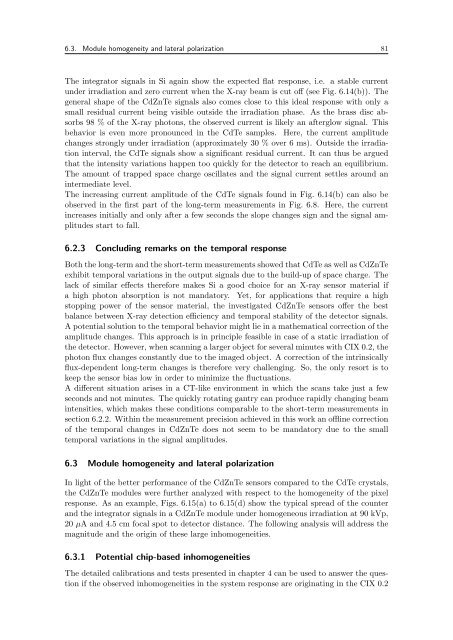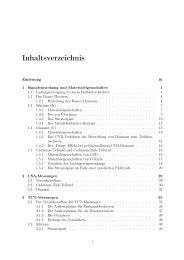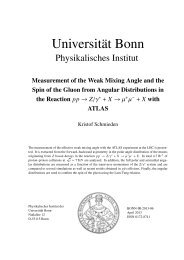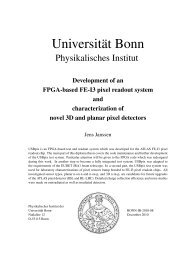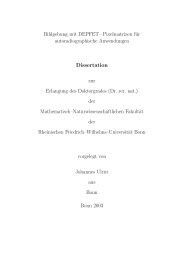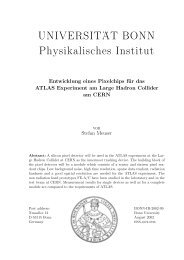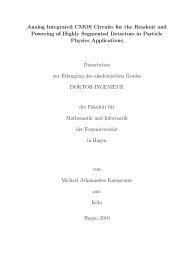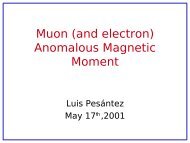UNIVERSIT . . AT BONN Physikalisches Institut - Prof. Dr. Norbert ...
UNIVERSIT . . AT BONN Physikalisches Institut - Prof. Dr. Norbert ...
UNIVERSIT . . AT BONN Physikalisches Institut - Prof. Dr. Norbert ...
You also want an ePaper? Increase the reach of your titles
YUMPU automatically turns print PDFs into web optimized ePapers that Google loves.
6.3. Module homogeneity and lateral polarization 81<br />
The integrator signals in Si again show the expected flat response, i.e. a stable current<br />
under irradiation and zero current when the X-ray beam is cut off (see Fig. 6.14(b)). The<br />
general shape of the CdZnTe signals also comes close to this ideal response with only a<br />
small residual current being visible outside the irradiation phase. As the brass disc absorbs<br />
98 % of the X-ray photons, the observed current is likely an afterglow signal. This<br />
behavior is even more pronounced in the CdTe samples. Here, the current amplitude<br />
changes strongly under irradiation (approximately 30 % over 6 ms). Outside the irradiation<br />
interval, the CdTe signals show a significant residual current. It can thus be argued<br />
that the intensity variations happen too quickly for the detector to reach an equilibrium.<br />
The amount of trapped space charge oscillates and the signal current settles around an<br />
intermediate level.<br />
The increasing current amplitude of the CdTe signals found in Fig. 6.14(b) can also be<br />
observed in the first part of the long-term measurements in Fig. 6.8. Here, the current<br />
increases initially and only after a few seconds the slope changes sign and the signal amplitudes<br />
start to fall.<br />
6.2.3 Concluding remarks on the temporal response<br />
Both the long-term and the short-term measurements showed that CdTe as well as CdZnTe<br />
exhibit temporal variations in the output signals due to the build-up of space charge. The<br />
lack of similar effects therefore makes Si a good choice for an X-ray sensor material if<br />
a high photon absorption is not mandatory. Yet, for applications that require a high<br />
stopping power of the sensor material, the investigated CdZnTe sensors offer the best<br />
balance between X-ray detection efficiency and temporal stability of the detector signals.<br />
A potential solution to the temporal behavior might lie in a mathematical correction of the<br />
amplitude changes. This approach is in principle feasible in case of a static irradiation of<br />
the detector. However, when scanning a larger object for several minutes with CIX 0.2, the<br />
photon flux changes constantly due to the imaged object. A correction of the intrinsically<br />
flux-dependent long-term changes is therefore very challenging. So, the only resort is to<br />
keep the sensor bias low in order to minimize the fluctuations.<br />
A different situation arises in a CT-like environment in which the scans take just a few<br />
seconds and not minutes. The quickly rotating gantry can produce rapidly changing beam<br />
intensities, which makes these conditions comparable to the short-term measurements in<br />
section 6.2.2. Within the measurement precision achieved in this work an offline correction<br />
of the temporal changes in CdZnTe does not seem to be mandatory due to the small<br />
temporal variations in the signal amplitudes.<br />
6.3 Module homogeneity and lateral polarization<br />
In light of the better performance of the CdZnTe sensors compared to the CdTe crystals,<br />
the CdZnTe modules were further analyzed with respect to the homogeneity of the pixel<br />
response. As an example, Figs. 6.15(a) to 6.15(d) show the typical spread of the counter<br />
and the integrator signals in a CdZnTe module under homogeneous irradiation at 90 kVp,<br />
20 µA and 4.5 cm focal spot to detector distance. The following analysis will address the<br />
magnitude and the origin of these large inhomogeneities.<br />
6.3.1 Potential chip-based inhomogeneities<br />
The detailed calibrations and tests presented in chapter 4 can be used to answer the question<br />
if the observed inhomogeneities in the system response are originating in the CIX 0.2


